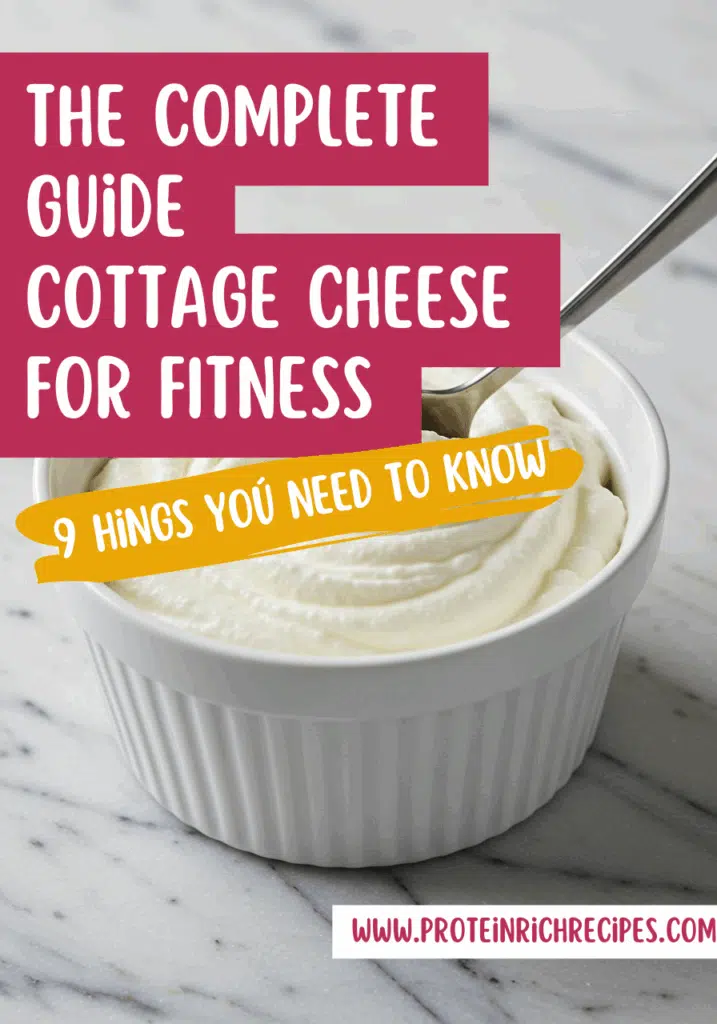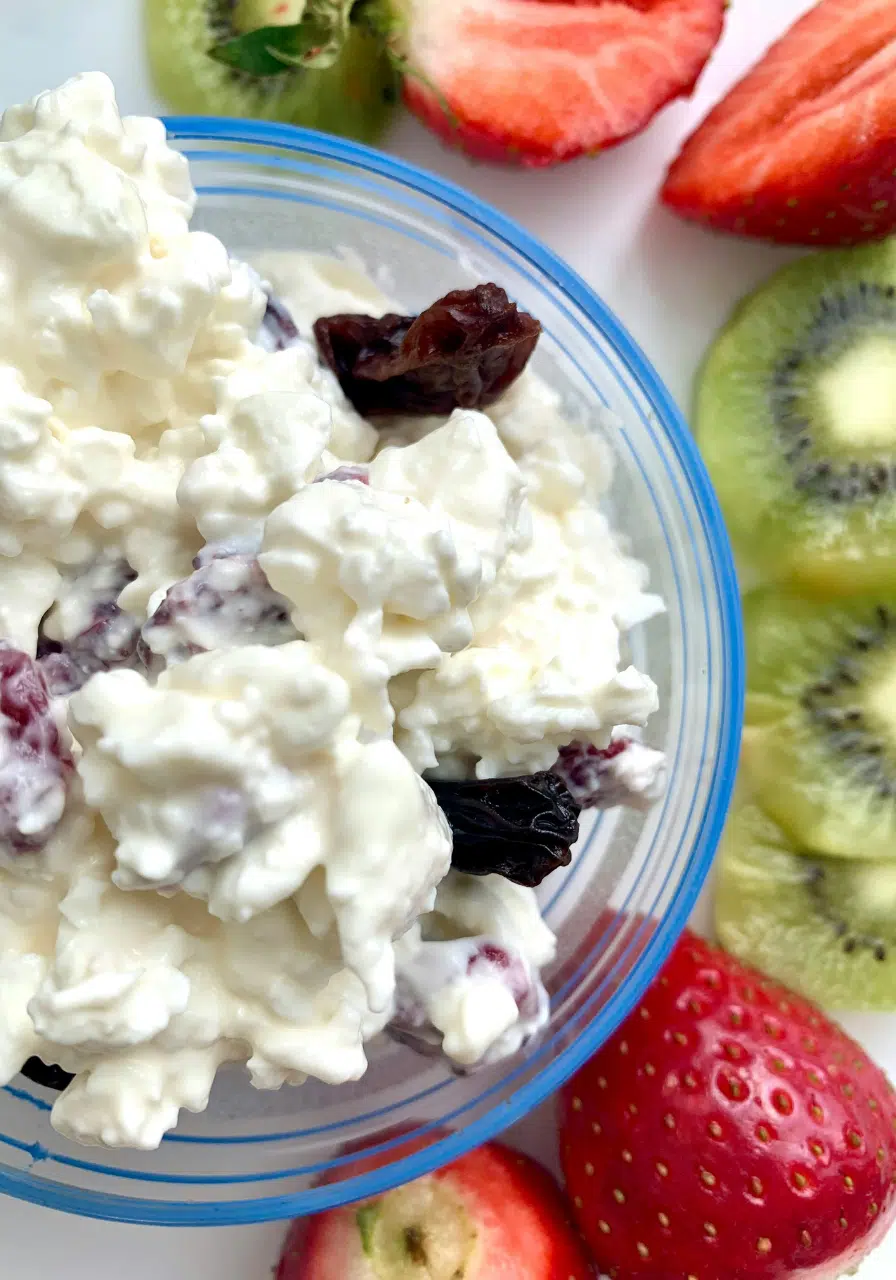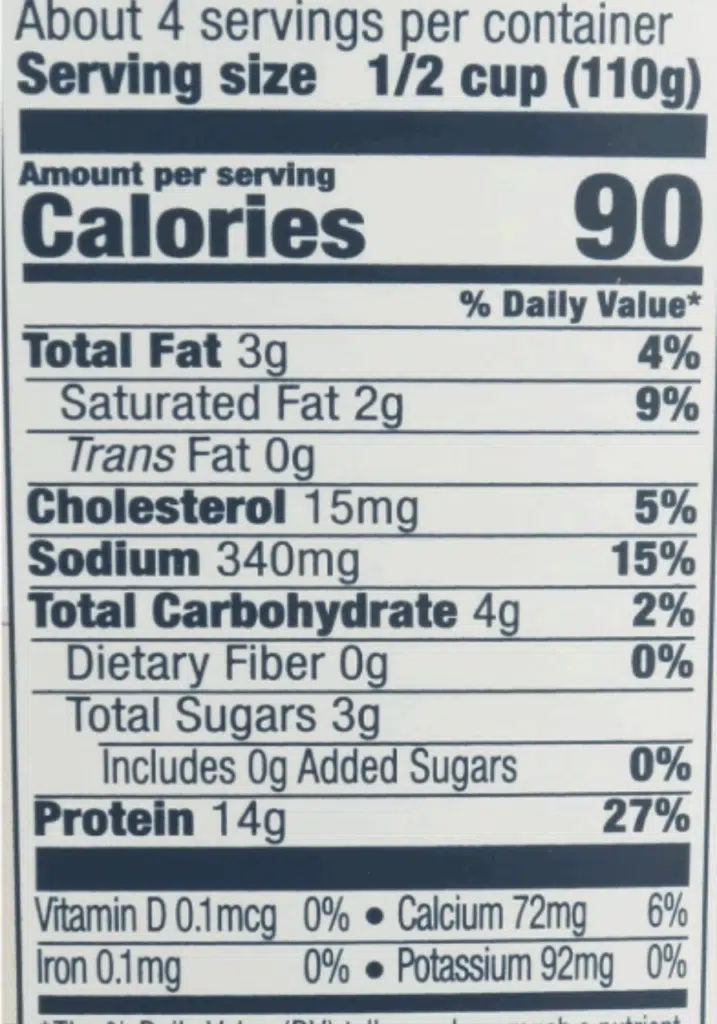Cottage cheese for fitness has earned a spot in gyms, kitchens, and meal-prep plans everywhere. We all know how frustrating it is to find foods that are high in protein, versatile, and actually satisfying, this is where cottage cheese shines. From supporting muscle recovery to helping with weight management, it’s a simple, nutrient-packed option for anyone focused on health or fitness.

This guide covers everything you need to know: nutrition, types, label reading, casein vs whey, benefits, risks, and practical ways to include cottage cheese in your daily routine.
Why Cottage Cheese for Fitness Is So Popular
Cottage cheese for fitness has become a staple in both bodybuilding and weight-loss circles, and for good reason. It’s a simple, protein-rich dairy food that delivers big benefits without much effort. Fitness communities love it because it’s versatile, easy to portion, and perfect as a snack, meal add-on, or bedtime recovery option.
Let’s be real: when you find a food that’s cheap, filling, and flexible in recipes, it’s a no-brainer. Cottage cheese gives you a slow-digesting, protein-rich option that helps with satiety and muscle maintenance, while still fitting into everything from smoothies to baked goods. (Looking for inspo? Check out all the cottage cheese recipes on the blog.)
Nutritional Profile of Cottage Cheese for Fitness
When it comes to cottage cheese for fitness, the numbers speak for themselves. A half-cup serving (about 113 g) typically provides 12–14 g of protein for around 80–100 calories, a pretty great protein-to-calorie ratio. Macros can shift depending on whether you grab non-fat, low-fat, or full-fat versions, so label-checking is key.
Beyond the macros, cottage cheese delivers useful micronutrients like calcium, selenium, vitamin B12, and phosphorus. It also contains leucine, the amino acid most linked to muscle growth, which explains why it’s been a bodybuilding favorite for decades.
►Methodology note: These values come from USDA databases and common product labels. Since brands vary, it’s best to double-check your own tub when tracking macros.
Cottage Cheese for Fitness: Muscle Building and Casein vs Whey
If your focus is building muscle, cottage cheese for fitness has a major edge: casein protein. Casein digests slowly, releasing amino acids over several hours, which can help reduce muscle breakdown and support recovery long after a meal. This is why many people use it as a nighttime snack, it fuels repair while you sleep.
Sure, whey protein shakes are great post-workout, but casein plays a different role. Research shows casein helps maintain a steady protein balance, making it perfect between meals or before bed. That steady trickle of amino acids? Exactly what your muscles need for long recovery windows.
Pro tip from the community: mix cottage cheese with fruit and nuts for a sweet bedtime snack, or go savory with tomatoes and cucumbers. Want more details? Dive deeper in our guide: Is Cottage Cheese Good for Muscle Building?.
Cottage Cheese for Fitness and Weight Management
Cottage cheese for fitness isn’t just about muscle, it’s also a weight-loss secret weapon. Its high protein helps keep you full longer, which naturally reduces snacking and makes it easier to stick to a calorie deficit. No joke, it’s one of the most filling protein foods per calorie.
The one thing to watch? Sodium. Some brands pack over 300 mg per serving, so it adds up quickly if you eat multiple portions a day. If you’re aiming for fat loss and healthy blood pressure, low-sodium options are worth hunting down.
►Pro community tip: pair cottage cheese with high-fiber foods like berries, oats, or chopped veggies. That combo not only boosts fullness but also balances out blood sugar. For more ideas, explore our Cottage Cheese Recipes for Weight Loss roundup.
Types of Cottage Cheese for Fitness: Fat, Sodium, and Lactose Explained

Not all cottage cheese for fitness is created equal. You’ll find non-fat, low-fat, and full-fat versions, and the right choice depends on your goals. Non-fat and low-fat give you the most protein per calorie, while full-fat offers extra creaminess and satiety if you need more calories.
Sodium can also vary a lot between brands. Some tubs deliver more than 20% of your daily sodium in just one cup. If you’re watching blood pressure, it’s smart to pick a low-sodium or “no salt added” version. And if you’re sensitive to lactose, cottage cheese usually has less lactose than milk, but lactose-free options are available too.
Quick Comparison Table
| Type | Avg. Protein (per ½ cup / 113g) | Avg. Calories | Best For… |
|---|---|---|---|
| Non-Fat | 13–14 g | 80–90 kcal | Cutting calories, maximizing protein-per-calorie |
| Low-Fat (1–2%) | 12–13 g | 90–110 kcal | Balanced option for most fitness goals |
| Full-Fat (4%) | 11–12 g | 120–140 kcal | Extra satiety, creamier texture, higher calorie needs |
How to Read the Label (4-Step Check)
- Protein per serving: aim for 10–14 g or higher.
- Sodium level: under 300 mg is a safe benchmark.
- Ingredients list: shorter is cleaner (milk, cream, salt, cultures).
- Fat %: pick non-fat, low-fat, or full-fat depending on calorie goals.
By checking these simple factors, you can quickly spot the type of cottage cheese that fits your personal fitness strategy.
How to Read Cottage Cheese Labels for Fitness

When choosing cottage cheese for fitness, the label is your best friend. Protein content, sodium levels, fat percentage, and additives all play a role in how well it fits your goals. Most tubs look similar at first glance, but the nutrition panel tells a very different story.
Here’s what to watch:
- Protein per serving: at least 10 g is a solid benchmark. Many fitness folks aim for 12–14 g per half cup.
- Sodium: regular varieties may contain 300–400 mg per serving, which adds up fast. Low-sodium versions can cut that in half. (Harvard T.H. Chan School of Public Health offers a sodium guide).
- Fat percentage: the label usually shows 0%, 1%, 2%, or 4%. This directly impacts calories and satiety.
- Ingredients: the shorter, the better. Look for just milk, cream, salt, and cultures. Extra gums and stabilizers aren’t harmful for most people, but many prefer simpler options.
Cottage Cheese for Fitness vs Other Protein Sources
Cottage cheese for fitness is great, but how does it stack up against other go-to proteins? Let’s break it down.
►Cottage Cheese vs Greek Yogurt
Both are high in protein, but Greek yogurt is slightly higher in carbs and usually contains whey protein, which digests faster. Cottage cheese, on the other hand, is rich in casein, making it the better “slow release” choice. Many athletes use both depending on timing. For a deeper dive, see our guide: Cottage Cheese vs Greek Yogurt.
►Cottage Cheese vs Protein Powder
Protein powder (whey, casein, or plant-based) is concentrated, convenient, and easy to track. But cottage cheese offers whole-food nutrition with calcium, selenium, and natural satiety. Think of powders as a supplement and cottage cheese as a whole-food base that supports your routine. Cleveland Clinic explains protein powder basics.
►Cottage Cheese vs Other Dairy (Ricotta, Cream Cheese)
Ricotta and cream cheese may taste similar, but they don’t hold up nutritionally. Ricotta is lower in protein and higher in carbs, while cream cheese is mostly fat. If fitness is the goal, cottage cheese wins every time.
Best Times to Eat Cottage Cheese for Fitness Goals
Timing can make cottage cheese for fitness even more effective. Because it’s rich in casein protein, it’s a smart choice before long gaps without food.
- Pre-workout: Not the best because it digests slowly, some athletes may feel too full.
- Post-workout: Works fine if you can’t get whey protein, but pair with faster carbs for recovery.
- Bedtime: Ideal. Cottage cheese provides steady amino acids overnight, reducing muscle breakdown. Research backs this studies show casein before sleep supports muscle protein synthesis. (See National Library of Medicine study).
- Snacks & breakfast: Great for satiety and balancing blood sugar when combined with fiber.
How to Add Cottage Cheese to a Fitness Diet
Adding cottage cheese for fitness is easier than most people think. It blends into sweet or savory meals, works in snacks, and even doubles as a cooking ingredient.
Practical uses:
- Smoothies: blend ½ cup cottage cheese with fruit for a creamier protein shake.
- Protein bowls: pair with berries, oats, or chia seeds.
- Savory meals: mix into salads, wraps, or even pasta sauces (try our High-Protein Cottage Cheese Pasta Sauce).
- Baked goods: swap part of the fat or dairy in muffins, pancakes, or bread with cottage cheese.
►Fitness communities often recommend using it in meal prep, add a scoop to overnight oats, or prep savory cottage cheese bowls with lean protein and veggies. For more inspiration, check out our full recipe collection.
Risks and Considerations of Cottage Cheese for Fitness
Even though cottage cheese for fitness is a powerhouse, it’s not for everyone. Here’s what to keep in mind:
- Sodium: Regular cottage cheese can be salty, which may be a concern for people with high blood pressure. Opt for low-sodium if you need to cut back. (American Heart Association on sodium).
- Lactose: While lower than milk, cottage cheese still contains lactose. Those with lactose intolerance may need lactose-free varieties or smaller servings. (Mayo Clinic: Lactose Intolerance Guide).
- Allergies: If you have a dairy allergy, cottage cheese isn’t suitable.
- Additives: Some flavored or creamed versions have added sugars or stabilizers, not harmful for most, but not ideal if you’re trying to keep things clean.
Expert Insights & Research References
To keep this guide science-backed and trustworthy, here are several reputable sources that highlight why cottage cheese is often recommended for fitness and overall health:
- USDA FoodData Central – Official nutrient database, providing the baseline values for calories, protein, fat, and sodium used throughout this article.
- Harvard T.H. Chan School of Public Health – Guidance on sodium intake and its long-term impact on cardiovascular health.
- Mayo Clinic – Overview of lactose intolerance and strategies for managing dairy in the diet.
- American Heart Association – Recommendations on sodium limits and healthy eating for heart health.
- Cleveland Clinic – Insights into protein powders versus whole-food protein sources like dairy.
- National Library of Medicine – Peer-reviewed research on casein protein, including studies showing benefits of pre-sleep protein intake for muscle repair.
► Methodology note: All nutrition facts in this article were cross-checked with USDA FoodData Central. External health claims were referenced from peer-reviewed journals or leading institutions to ensure accuracy.
expert tips
►A quick tip: if you’re managing weight or blood pressure, scan for “low sodium” or “no salt added.” If muscle gain or fullness is the goal, don’t be afraid of full-fat options. Label literacy is what makes cottage cheese for fitness work long-term.
►Community tip: a lot of fitness enthusiasts call cottage cheese the “night snack king” because it’s one of the few foods proven to work while you sleep.
►Bottom line: cottage cheese is safe for most healthy adults, but like any food, it works best when chosen thoughtfully.
Frequently Asked Questions About Cottage Cheese for Fitness
Is cottage cheese good for fitness?
Yes, cottage cheese is packed with protein, calcium, and slow-digesting casein, making it a solid choice for muscle recovery and weight management. Its balance of macros supports both fat loss and lean muscle gain.
Why do athletes eat cottage cheese?
Athletes often choose cottage cheese because casein protein digests slowly, feeding muscles with amino acids for hours. This is especially useful before bed or between meals to reduce muscle breakdown.
Is it okay to eat cottage cheese every day?
For most healthy adults, yes. Daily cottage cheese fits into many balanced diets, especially if you vary the type (low-fat vs full-fat) and watch sodium levels. If you’re lactose intolerant, opt for lactose-free versions.
Can I just eat cottage cheese for protein?
You could, but relying on a single source isn’t ideal. While cottage cheese is rich in protein, variety ensures you get a full spectrum of nutrients and amino acids. It’s best to mix cottage cheese with other proteins like chicken, fish, beans, or Greek yogurt.
final thoughts
Cottage cheese for fitness is one of those rare foods that’s cheap, filling, and incredibly versatile. It supports muscle building with slow-digesting casein, helps weight loss by keeping you full, and adapts easily into almost any meal. From non-fat to full-fat, there’s a version to fit nearly every goal.
To get the most out of it, choose wisely: check labels for protein and sodium, time your servings around recovery windows, and use it creatively in recipes. Whether you’re building muscle, managing weight, or just eating smarter, cottage cheese has a place on your table.


